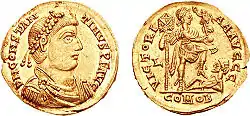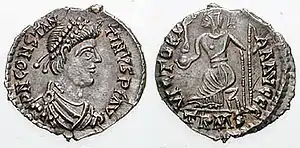Constantine III (Western Roman emperor)
Flavius Claudius Constantinus,[2] known in English as Constantine III (died shortly before 18 September 411), was a Roman general who declared himself Western Roman Emperor in Britannia in 407 and established himself in Gaul. He was co-emperor from 409 until 411.[3]
| Constantine III | |||||
|---|---|---|---|---|---|
 Coin of Constantine III | |||||
| Roman emperor | |||||
| Reign | Usurper 407–409 (against Emperor Honorius) Co-emperor 409–411 (with Honorius and Constans II) | ||||
| Predecessor | Gratian | ||||
| Successor | Honorius | ||||
| Died | 411 (before 18 September) | ||||
| Issue | Constans II Julianus,[1] Ambrosius Aurelianus (legend) Uther Pendragon (legend) | ||||
| |||||
| Religion | Nicene Christianity | ||||
Constantine rose to power during a bloody struggle in Roman Britain and was acclaimed emperor by the local legions in 407. He promptly moved to Gaul, taking all of the mobile troops from Britain, to confront the various Germanic invaders who had crossed the Rhine the previous winter. Constantine gained the upper hand after several battles with the forces of the Western Roman Emperor Honorius. As a result, Honorius recognised Constantine as co-emperor in 409. The activities of the invading tribes, raids by Saxons on the near-defenseless Britain and desertions by some of his top commanders led to a collapse of support. After further military setbacks he abdicated in 411. He was captured and executed shortly afterwards.
Life

In 406, the provinces of Roman Britain revolted. The garrisons had not been paid and had determined to choose their own leader.[4] Their first two choices, Marcus and Gratian, did not meet their expectations and were killed. Fearful of a Germanic invasion and desperate for some sense of security in a world that seemed to be rapidly falling apart, the Roman military in Britain sought greater security in strong and able military leadership and chose as their leader a man named after the famed emperor of the early fourth century, Constantine the Great, who had himself risen to power through a military coup in Britain.[5] Constantine was a common soldier, but one of some ability.[6] Early in 407, they acclaimed him as emperor.[7][2]
Constantine moved quickly. He crossed the Channel at Bononia (Boulogne) and (historians have assumed) took with him all of the mobile troops left in Britain, thus denuding the province of any first line military protection and explaining the disappearance of the legions from Britannia in the early fifth century.[8] The Roman forces in Gaul (modern France) declared for him, followed by most of those in Hispania (modern Spain). On 31 December 406 several tribes of barbarian invaders, including the Vandals, the Burgundians, the Alans and the Sueves had crossed the Rhine, perhaps near Mainz, and overrun the Roman defensive works in a successful invasion of the Western Roman Empire.[9]
Constantine's forces won several confrontations with the Vandals and quickly secured the line of the Rhine. The sitting Western emperor, Honorius, ordered Stilicho, his leading general, or magister militum, to expel Constantine. Sarus the Goth, a commander of Honorius, defeated two of Constantine's generals, Iustinianus and the Frank Nebiogastes, who were leading the vanguard of his forces.[10] Constantine's lieutenant, Nebiogastes, was first trapped in, then killed outside, Valence.[11] Constantine sent another army headed by Edobichus and Gerontius, and Sarus retreated into Italy, needing to buy his passage through the Alpine passes from the brigand Bagaudae, who controlled them.[12] With these advances, Constantine controlled all of Gaul and garrisoned the Alpine passes into Italy.[13] By May 408 he had made Arles his capital,[14] where he appointed Apollinaris, the grandfather of Sidonius Apollinaris, as prefect.[15]
Recognition as co-emperor
In the summer of 408, the Roman forces in Italy assembled to attack Constantine. Hispania was a stronghold of the House of Theodosius[14] and loyal to the ineffectual Honorius. Constantine feared that Honorius' cousins would organise an attack from that direction while troops under Sarus and Stilicho attacked him from Italy in a pincer manoeuvre. He struck first at Hispania.[16] He summoned his eldest son, Constans, from the monastery where he was dwelling, elevated him to Caesar,[17] and sent him with the general Gerontius towards Hispania,[8] where they defeated the cousins of Honorius with little difficulty; two – Didymus and Verinianus – were captured, and two others – Lagodius and Theodosiolus – escaped, Lagodius to Rome and Theodosiolus to Constantinople.[18]
Constans left his wife and household at Saragossa under the care of Gerontius and returned to Arles to report to his father.[19] Meanwhile, the loyalist Roman army mutinied at Ticinum (Pavia) on 13 August, which was followed by the execution of Honorius' general Stilicho on 22 August.[18] Intrigue within the Imperial court caused the general Sarus and his men to abandon the western army. This left Honorius in Ravenna without any significant military power, and facing a Gothic army under Alaric that roamed unchecked in northern Italy. So, when Constantine's envoys arrived to parley, the fearful Honorius recognised Constantine as co-emperor, and the two were joint consuls for the year 409.[19]
March on Italy
That year was Constantine's high-water mark. While he had been fighting Honorius' armies, some of the Vandal tribes had overrun Constantine's Rhine defenses and spent two years and eight months burning and plundering their way through Gaul. The tribes reached the Pyrenees, where they broke through Constantine's garrisons and entered Hispania.[8] Constantine prepared to send his son Constans back to deal with this crisis when word came that his general Gerontius had rebelled, raising his relative, Maximus of Hispania, as co-emperor.[10] Despite Constantine's best efforts, the feared attack from Hispania came the following year, when Gerontius advanced with the support of his barbarian allies.[20]
At about the same time Saxon pirates raided Britain, which Constantine had left defenceless.[21] Distressed that Constantine had failed to defend them, the Roman inhabitants of Britain and Armorica (Brittany) rebelled and expelled his officials.[17][22]
Constantine's response to this tightening circle of enemies was a final desperate gamble. Encouraged by the entreaties of officials of the western court, he marched on Italy with the troops left to him. They wanted to replace Honorius with a more capable ruler.[8] Constantine, though, had insufficient forces and retreated into Gaul in the late spring of 410.[8] Constantine's position became untenable; Gerontius defeated his forces at Vienne in 411; there his son Constans was captured and executed.[10] Constantine's praetorian prefect Decimus Rusticus, who had replaced Apollinaris a year earlier, abandoned Constantine to be caught up in the new rebellion of Jovinus in the Rhineland. Gerontius trapped Constantine inside Arles and besieged him.[8]
Surrender and execution
At the same time, Honorius found a new general, the future Constantius III. He arrived at Arles and put Gerontius to flight. Gerontius committed suicide and many of his troops deserted to Constantius, who took over the siege. Constantine held out, hoping for the return of Edobichus, who was raising troops in northern Gaul amongst the Franks.[21] But on his arrival Edobichus was defeated in an ambush.[23] Constantine, his hopes fading after his troops guarding the Rhine abandoned him to support Jovinus, surrendered to Constantius. Despite the promise of safe passage, and Constantine's assumption of clerical office, Constantius imprisoned the former soldier and had him beheaded on his way to Ravenna in either August or September 411.[2] His head was mounted on a pole and presented to Emperor Honorius on 18 September. It was later displayed outside Carthage.[24]
Athaulf the Visigoth later suppressed the revolt of Jovinus. Roman rule never returned to Britain after the death of Constantine III. As the historian Procopius later explained, "from that time onwards it remained under [the rule] of tyrants."[25]
Legend
Constantine III is also known as Constantine II of Britain. He is often confused with the Constantine found in Geoffrey of Monmouth's highly popular and imaginative Historia Regum Britanniae, who comes to power following Gracianus Municeps' reign. In Geoffrey's account, the Britons ask Aldroenus, the ruler of Armorica, to be their ruler after the Roman withdrawal, seeking a king who can defend them against the barbarians. Aldroenus refuses, believing the country to have diminished, but sends his brother Constantine to rule instead. Constantine becomes king and has three sons, Constans, Aurelius and Uther, but is stabbed to death by a Pict.[26]
Constantine III is of no relation to the Constantine described in Geoffrey's account and he has no link to the legend of King Arthur. Geoffrey's Constantine is the brother of Aldroenus, both of whom were the descendants of Conan Meriadoc. It is Geoffrey's Constantine who, through his son Uther Pendragon, becomes the grandfather of the legendary King Arthur.
See also
References
- Jones, pg. 638
- Jones, pg. 316
- Doyle, Chris (2014). The Endgame of Treason: Suppressing Rebellion and Usurpation in the Late Roman Empire AD 397‑411. National University of Ireland Galway. Unpublished doctoral thesis. pp. 163–192.
- Zosimus, 6:1:2
- Zosimus, 7:40:5
- Orosius, 7:40:4
- Snyder 1998:19, Age of Tyrants.
- Elton, Constantine III (407–411 A.D.)
- Bury, pg. 138
- Birley, pg. 460
- Zosimus, 6:2:3
- Zosimus, 6:2:4
- Birley, pgs. 458–459
- Bury, pg. 140
- Jones, pg. 113
- Zosimus, 6:2:5
- Birley, pg. 459
- Gibbon, Ch. 30
- Bury, pg. 141
- Bury, pg.142
- Bury, pg. 143
- Higham 1992, pp. 71–72.
- Bury, pg. 144
- Heather, pg. 237
- Birley, pg. 160
- Monmouth, 6:5
Sources
Primary sources
- Zosimus, Historia Nova, Books 5 & 6 Historia Nova
- Orosius, Historiae adversum Paganos, 7.40
- Geoffrey of Monmouth' Historia Regum Britanniae
Secondary sources
- Bartrum, Peter A Welsh Classical Dictionary Cardiff: National Library of Wales, 1993, ISBN 978-0-907158-73-8
- Birley, Anthony (2005), The Roman Government in Britain, Oxford: Oxford University Press, ISBN 978-0-19-925237-4
- Bury, J. B., A History of the Later Roman Empire from Arcadius to Irene, Vol. I (1889) London; New York: Macmillan OCLC 22138662
- Elton, Hugh, Constantine III (407–411 A.D.), D.I.R.
- Ford, David Nash Early British Kingdoms: Constantine Corneu
- Gibbon, Edward, Decline and Fall of the Roman Empire (1888) Philadelphia : J.B. Lippincott OCLC 692266633
- Heather, Peter(2005) The Fall of the Roman Empire, Basingstoke and Oxford: Pan Macmillan ISBN 978-0-333-98914-2
- Higham, Nicholas (1992), Rome, Britain and the Anglo-Saxons, London: B. A. Seaby, ISBN 978-1-85264-022-4
- Jones, Arnold Hugh Martin, John Robert Martindale, John Morris, The Prosopography of the Later Roman Empire, volume 2, Cambridge University Press, 1992, ISBN 978-0-521-20159-9
- Snyder, Christopher A. (1998), An Age of Tyrants: Britain and the Britons A.D. 400–600, University Park: Pennsylvania State University Press, ISBN 978-0-271-01780-8
- Stevens, C.E. "Marcus, Gratian, Constantine", Athenaeum, 35 (1957), pp. 316–47
- Thompson, E.A. "Britain, A.D. 406–410", Britannia, 8 (1977), pp. 303–318.
External links
| Wikimedia Commons has media related to Constantine III (usurper). |
| Political offices | ||
|---|---|---|
| Preceded by Anicius Auchenius Bassus Flavius Philippus |
Consul of the Roman Empire 409 with Honorius and Theodosius II |
Succeeded by Varanes Tertullus |
| Legendary titles | ||
| Vacant Title last held by Gracianus Municeps |
King of Britain 407–411 |
Succeeded by Constans |
